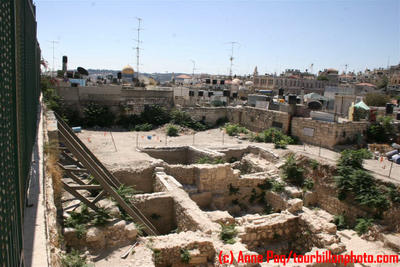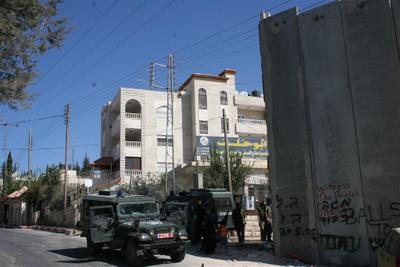

Une nouvelle colonie a ete planifiee en plein coeur du quartier arabe de la vieille ville de Jerusalem!/
A new settlement has been planned at the heart of the Arab quarter of the Old City of Jerusalem!
Chroniques d'une photographe,specialiste des droits humains en Palestine et ailleurs, Chronicles of a French photographer, specialist in human rights, in Palestine and elsewhere




“The
By Ilan Pappé *
There is an amazing gap between the global discourse on the Gaza Disengagement Plan of the
This imbalance between representation and reality makes it difficult to assess and discuss the significance of the
For instance, the removal of the provocative settlements from the Gaza Strip and from a small area in the north of the
Moreover, regardless of its real motives, the move could advance the Palestinian right to self-determination. This is a position argued by the Islamic forces in the OPTs, which see the pullout as the defeat of the occupying army, and there is indeed more than a modicum of truth in this representation. However, for these two positive aspects to materialize as a new reality, the withdrawal must mean a genuine Israeli detachment from the lives of the Palestinians in the Gaza Strip and northern parts of the
Unfortunately, there is very little evidence to suggest that this will in fact be the outcome of the disengagement. The first omen is the Israeli insistence that there will be no further territorial concessions. While this position is not always stated openly, it was spelled out clearly by Dov Weissglas, Ariel Sharon's senior aide, in an interview with Ha'aretz on
Furthermore, the Israelis have minimized, as far as possible, any cooperation with the Palestinian Authority on the withdrawal in order to avoid creating any domestic impression that the pullout is part of a peace dialogue, and not, as they wish to portray it, the redeployment of forces.
These declarations fit well with the overall strategy of the
Thus, the wider context for analyzing the impact of the Disengagement Plan on human rights is
At the very least, one can expect a similar level of resistance to that currently being attempted by the various Palestinian forces in their desperate struggle against the status quo (although one can even envisage far worse scenarios). Let us assume, for the sake of argument, that the frustration in the Palestinian areas will not result in actions that exceed the known patterns of attacks against the army and settlers from both the Gaza Strip and the
Three senior Israelis—the Prime Minister, the Minister of Defense and Eival Giladi, the Director of the Strategic Coordination Staff in the Prime Minister's Office—have already explained what the Israeli retaliation would be against such a Palestinian reaction. Giladi told the printed and electronic press that, "Israel will act in a very resolute manner in order to prevent terror attacks and militant fire while the disengagement is being implemented … and if pinpoint response proves insufficient, we may have to use weaponry that causes collateral damage, including helicopters and planes, with mounting danger to surrounding people" (Ha'aretz, 22 June 2005).
A month later, Tawfiq abu Husa, spokesperson for the Palestinian Ministry of the Interior, notified the Israelis that the Ministry could not secure a peaceful pullout (www.walla.co.il,
According to the book, in order to 'rehabilitate' the loss of 'Arab respect' for the army, back in 2000 and 2001 Mofaz foiled any serious attempt made by the Palestinians and moderate Israelis to end the military escalation of the second Intifada. The book shows that the Disengagement Plan was concocted by Ariel Sharon, after learning that then-state prosecutor Edna Arbel was about to indict him on corruption charges. The army went along with the plan, although most of Mofaz's colleagues rejected it. The army's position is quite puzzling. All of its senior officers said openly and in internal debates that a unilateral withdrawal would be a disaster. Eventually, however, all, to a man, came out in its favor. Why did the IDF agree to a plan it thought was disastrous? According to the book, because it bent to heavy political pressure from a Prime Minister who was convinced he would be prosecuted for his political and financial corruption. Indeed, the army chiefs continue to argue that after the withdrawal there is likely to be more fire directed from the Strip at Jewish towns within pre-1967
The likelihood that the disengagement will not end the occupation, but rather perpetuate it, is in itself bad news for the future human and civil rights of the Palestinians. The possibility of brutal Israeli actions leading to massive killing within the Gaza Strip is also troubling, to say the least. Moreover, the Israeli insistence on disconnecting the Strip from any land contact to the east, north and south, and on continuing to blockade it from the sea to the west, raises genuine concerns about the economic standard of living and social welfare of its more than 1.4 million Palestinian residents.
It is quite likely, then, that Palestinians will pay for the 'national trauma,' in order that both the 'nation' and the army can feel healed after the crisis is over. However, far more important is the possible sense of success that will descend on the Israeli policy-making apparatus, should the withdrawal be implemented relatively smoothly. It would be considered a victory for 'unilateralism,' which is now the mantra of the consensual political center in the country.
‘Unilateralism' means that the Palestinians, wherever they are—inside Israel, in the refugee camps, in the Diaspora or in the OPTs—have no say in the future of Palestine and Israel. Hence, laws can be passed to prevent Palestinian marital partners from different sides of the Green Line from living together in Israel, with total disregard to the wishes of the Palestinians themselves (in July 2005, 59 members of Knesset voted to extend this law, with minor amendments, whilst only 13 voted against it, although in fact more than 100 out of 120 Israeli members of Knesset support this racist legislation). In addition, Israeli security arrangements in the form of the wall and other defensive means can be decided upon regardless of any concern for what the Israeli Supreme Court euphemistically calls "the comfort of the Palestinians." By now it has been well documented that these means have caused the transfer of people, the loss of their livelihood and their imprisonment between huge walls and army lookout towers.
After the withdrawal, which is portrayed domestically as a national trauma not to be repeated, and to the world at large as the bravest peace plan ever proposed to the Palestinians, 'unilateralism' is in danger of becoming sacrosanct. In terms of human rights, this means that in the aftermath of the disengagement the Israeli agencies dealing with the Palestinians under their control will pursue the same callous policies described above with even less regard to Palestinian opinion or rights. Against the mood and discourse of 'significant concessions'—as with the talk of 'the most generous offer' in the summer of 2000—the Israeli authorities will have no scruples in determining, with brutal force, who the Palestinians can marry, where they can live and work, when they can go out or for how long they have to stay imprisoned in their homes before curfews and closures are lifted. Worse, the army will be able to continue its policies of shooting and killing without any inhibitions.
Within
However, the government and its agencies' overall treatment of the protest movement serves to highlight a different aspect of human and civil rights in Israel: the wide gap between the ways in which Palestinian and Jewish citizens of Israel engaged in protests against the government are dealt with. Some of the actions undertaken by the protestors were identical to those undertaken during the protest demonstrations held by Palestinian citizens of
Although the settlers and their supporters have been engaging in such activities for several months, the police have responded almost entirely through non-violent means resulting in almost no injuries. Detainees have been held for relatively short periods of time. In October 2000, 13 unarmed Palestinian citizens of
The discrimination evident in the means of dealing with these two cases is a portentous omen for the future. It suggests not only that Israel will attempt to evade withdrawal from any further occupied land and avoid conducting genuine peace negotiations with the Palestinians, but also that it will maintain the current regime of segregation and discrimination within Israel, allowing extreme right wingers to perpetuate Israeli intransigence and preventing Palestinian and non-Zionist political groups in Israel from enjoying their basic rights to freedom of _expression and political participation.
In short, the Disengagement Plan is a step toward consolidating an Israeli regime of discrimination inside the state, as well as the policies of occupation, colonization, and, potentially, massive killing in the OPTs. The regrettable misconception of the move in the international media will allow the Israeli government to continue to pursue its plans. As in the past, it remains the duty of the civil societies in the West to expose this distorted picture and to exert pressure on their governments to demand a total Israeli withdrawal from all of the territories it occupied in 1967 and the introduction of international peace-keeping forces in their place. These developments would bring relief to those living under occupation, after enduring almost 40 years of the systematic abuse of their human and civil rights. International protection should be provided for the Palestinians until all the outstanding problems—the refugee issue, the question of